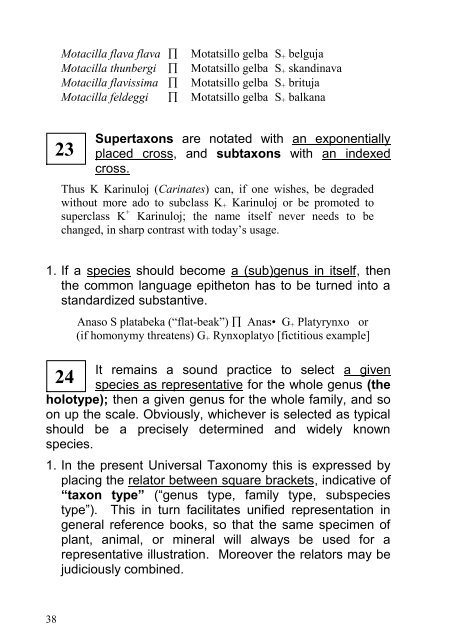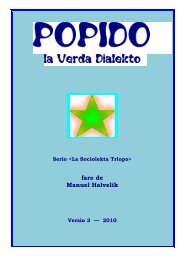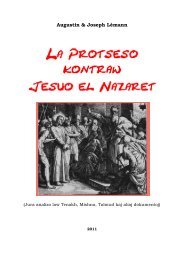the TRIMERAL SYSTEM in BIOLOGICAL TAXONOMY - universala ...
the TRIMERAL SYSTEM in BIOLOGICAL TAXONOMY - universala ...
the TRIMERAL SYSTEM in BIOLOGICAL TAXONOMY - universala ...
Create successful ePaper yourself
Turn your PDF publications into a flip-book with our unique Google optimized e-Paper software.
38<br />
Motacilla flava flava Motatsillo gelba S+ belguja<br />
Motacilla thunbergi Motatsillo gelba S+ skand<strong>in</strong>ava<br />
Motacilla flavissima Motatsillo gelba S+ brituja<br />
Motacilla feldeggi Motatsillo gelba S+ balkana<br />
23<br />
Supertaxons are notated with an exponentially<br />
placed cross, and subtaxons with an <strong>in</strong>dexed<br />
cross.<br />
Thus K Kar<strong>in</strong>uloj (Car<strong>in</strong>ates) can, if one wishes, be degraded<br />
without more ado to subclass K+ Kar<strong>in</strong>uloj or be promoted to<br />
superclass K + Kar<strong>in</strong>uloj; <strong>the</strong> name itself never needs to be<br />
changed, <strong>in</strong> sharp contrast with today’s usage.<br />
1. If a species should become a (sub)genus <strong>in</strong> itself, <strong>the</strong>n<br />
<strong>the</strong> common language epi<strong>the</strong>ton has to be turned <strong>in</strong>to a<br />
standardized substantive.<br />
Anaso S platabeka (“flat-beak”) Anas• G+ Platyrynxo or<br />
(if homonymy threatens) G+ Rynxoplatyo [fictitious example]<br />
It rema<strong>in</strong>s a sound practice to select a given<br />
24<br />
species as representative for <strong>the</strong> whole genus (<strong>the</strong><br />
holotype); <strong>the</strong>n a given genus for <strong>the</strong> whole family, and so<br />
on up <strong>the</strong> scale. Obviously, whichever is selected as typical<br />
should be a precisely determ<strong>in</strong>ed and widely known<br />
species.<br />
1. In <strong>the</strong> present Universal Taxonomy this is expressed by<br />
plac<strong>in</strong>g <strong>the</strong> relator between square brackets, <strong>in</strong>dicative of<br />
“taxon type” (“genus type, family type, subspecies<br />
type”). This <strong>in</strong> turn facilitates unified representation <strong>in</strong><br />
general reference books, so that <strong>the</strong> same specimen of<br />
plant, animal, or m<strong>in</strong>eral will always be used for a<br />
representative illustration. Moreover <strong>the</strong> relators may be<br />
judiciously comb<strong>in</strong>ed.






